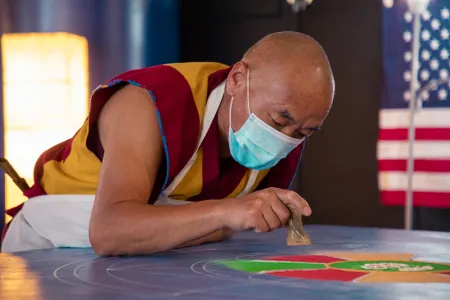It’s midday on Thursday, November 3, and the Campus Center lobby is typically busy as students, faculty, and staff make their way to and from lunch and class. In contrast to the bustle, two Tibetan monks from the Namgyal Monastery Institute of Buddhist Studies—Ithaca College’s neighbor on South Hill—are calmly bending over a five-foot square table, painstakingly sprinkling grains of colored sand into place in the construction of a mandala.
Ordered and geometric in design, mandalas (pronounced MAHN’-duh-luh) are found in Tibetan Buddhism and other religious traditions and can be thought of as abstract depictions of the palace of a celestial being.
Although incredibly artistic, they are considered much more than works of art. Eric Steinschneider, assistant professor in the Department of Philosophy and Religion, who spearheaded bringing the mandala build to Ithaca College, likens them to an architect’s blueprint—essentially two-dimensional representations that function as plans for the construction of what are, in fact, three-dimensional structures in contemplative rituals.

